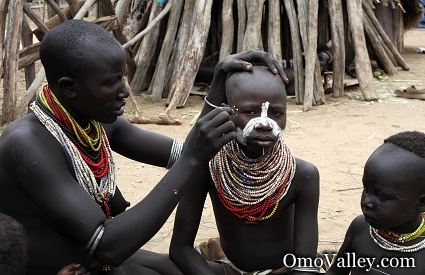
Kara Tribe
The Karo or Kara is a small tribe with an estimated population between 1,000 and 3,000. They are closely related to the Kwegu tribe. They live along the east banks of the Omo River in southern Ethiopia and practice flood retreat cultivation. The crops that are grown by them are sorghum, maize and beans. Only small cattle are kept because of the tsetse flies. These flies are large and consume the blood of vertebrate animals.
Like many of the tribes in the Omo, they paint their bodies and faces with white chalk to prepare for a ceremony. The chalk is mixed with yellow rock, red iron ore and charoal to make its color. Face masks are worn at times and they have clay hair buns with feathers in them. Red clay mixed with butter is put into their hair and clothing is made from animal skin. The women scar their chest believing it makes them beautiful.
The men's scars represent an enemy or dangerous animal killed. They also wear clay hair buns which symbol a kill. A man in the tribe can have as many wives as he wants, but must be able to afford them. Most men will only marry two or three.
The traditional bull jumping is a rite of passage for men coming of age. The event last three days and a hut used by the Hamer or Hamar tribe involves only castrated cattle. The man must jump over a line of 10 to 30 bulls four times completey nude without falling. If this task is complete, the man joins the ranks of the Maza. Maza are other men that have successfully completed the bull jumping event. During this ceremony, the women of the tribe provoke the maza to whip them on their bare backs. This is extrememly painful and causes severe scaring on the women. The scars are a symbol of devotion to the men and are encourged by the tribe. Night dancing called evangadi is also a hamer tradition.